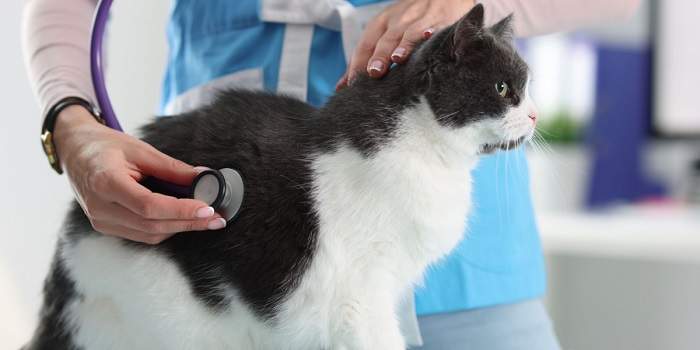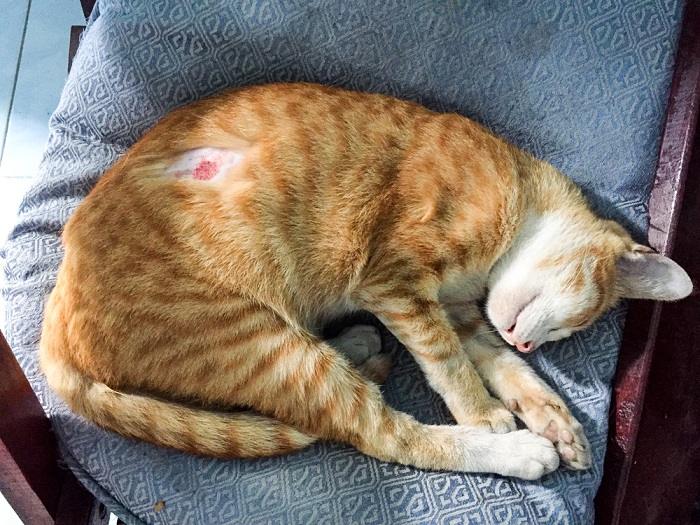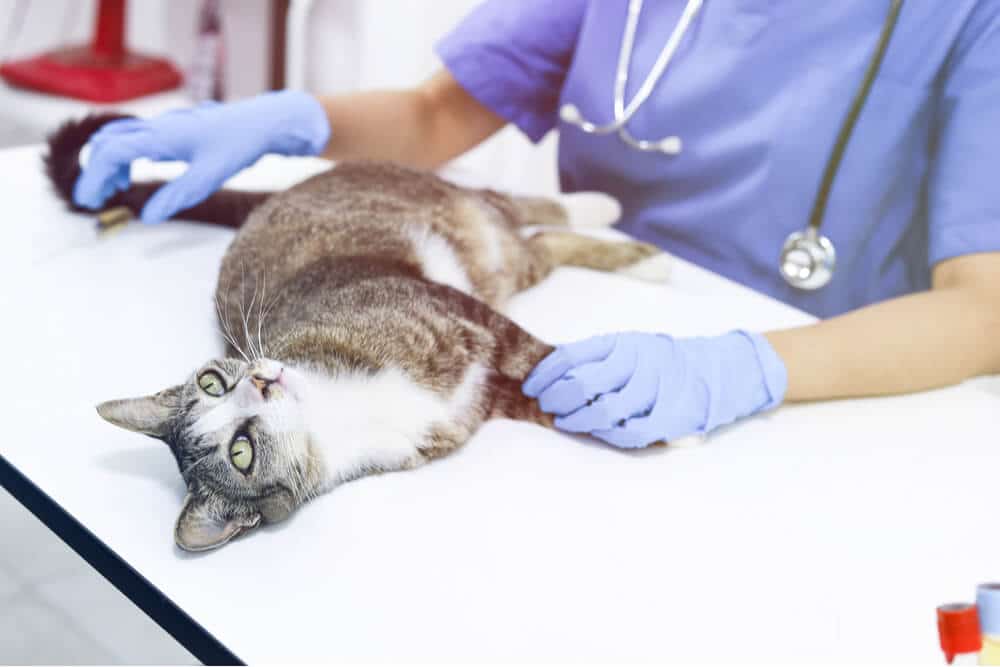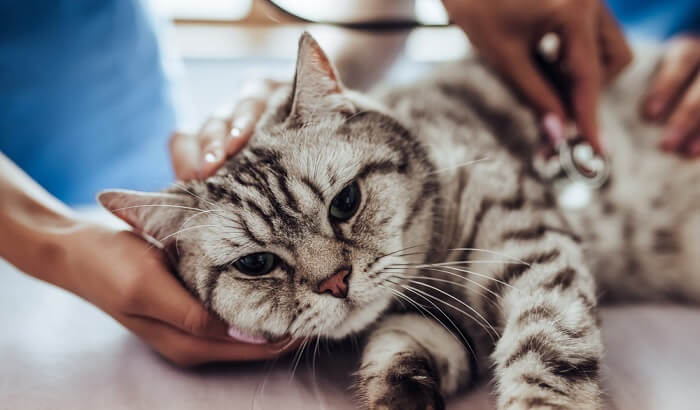
Pneumothorax is also known as a collapsed lung. Pneumothorax in cats develops when air leaks into the space inside the chest around the lung. This space (known as the “pleural cavity”) is normally a “non-space,” i.e. the lungs are normally kept in direct contact with the inner lining of the chest. It is a veterinary emergency that needs to be taken very seriously.
The aim of this article is to provide a simple, clear explanation of what pneumothorax is for cat owners, the symptoms, signs, and what to do if their cat is affected.
Quick Overview: Pneumothorax In Cats (Cat Collapsed Lung)








What Is Pneumothorax?
The word “pneumothorax” is derived from the Greek words “pneuma” meaning “air”, and “thorax” meaning “chest.”
Broadly speaking, there are two types of pneumothorax.
- “Open pneumothorax” describes a situation where there is an opening into the chest cavity from the outside, allowing atmospheric air to leak in.
- “Closed pneumothorax” happens when there is no direct leak from the outside, and instead, air leaks from internal structures (e.g. lungs or windpipe) into the space around the lungs.
Pneumothorax can also be divided into three other sub-types which relate to the reason for the condition to develop.
- Traumatic pneumothorax reflects the most common cause, which occurs after some sort of traumatic episode such as bites, road accidents, gunshots, or falling from a height.
- Iatrogenic pneumothorax describes a situation where the air enters the thoracic cavity following a veterinary procedure.
- Spontaneous pneumothorax is reported occasionally in cats with lung diseases such as feline asthma.
Tension pneumothorax is a special type of pneumothorax when the pressure of the air gathered inside the thoracic cavity is greater than the outside atmospheric pressure. This presents as a particularly severe type of crisis, as the increased pressure around the lungs prevents a cat from taking in air.
This is the type of pneumothorax that is seen in movies, when a heroic passer-by saves a collapsed person who cannot breathe, by inserting a sharp object into the chest, creating an out rushing of air and immediate relief of the difficulty breathing.
How Common Is Pneumothorax?
Traumatic pneumothorax is a common consequence of trauma to the chest wall, while iatrogenic pneumothorax is a rare complication of veterinary procedures. Spontaneous pneumothorax is also rare in cats, but mild examples are sometimes seen in cats with asthma.
How Do Cats Get Pneumothorax?
Pneumothorax develops when air gathers in the space between the lungs and the inner surface of the thoracic wall. Normally, this space is a virtual vacuum, which causes the surface of the lungs to remain closely applied to the inside of the chest wall, in the same way as a suction cap remains stuck to a smooth surface.
When air enters this space (called the “pleural cavity”), the lung is no longer held tightly to the inside of the chest wall, and so it collapses.
Symptoms of Pneumothorax in Cats
When the lungs collapse during pneumothorax, the cat is no longer able to inflate the lungs by expanding and contracting the chest cavity as normal. For this reason, breathing difficulties (dyspnea) and respiratory distress are the main clinical signs of severe pneumothorax in cats.
However, in early or mild cases, other signs that may be seen include dullness, inappetence, weakness, collapse, and coughing. Cyanosis (a blue/purple color of the mucous membranes such as the gums) may be noticed.
Sometimes an affected cat may have an unusual posture, with their head held forwards, their body pressed down on the sternum, and their forelimbs pushed down and to one side, in an effort to maximize the amount of air that they are breathing in. Owners may also notice so-called “abdominal breathing”, which describes the fact that the abdomen will be moving in and out far more than normal because the cat is unable to get enough oxygen via normal chest movements due to the pneumothorax.
Sometimes subcutaneous emphysema (the presence of free air under the skin) is also noticed: this can be felt as a crinkly type of “bubble wrap” sensation when the skin is felt.
In cases of traumatic pneumothorax, owners may notice external injuries such as cuts or bite marks to the chest wall.
Causes of Pneumothorax in Cats

Traumatic pneumothorax happens sometimes after a cat sustains a physical injury.
Traumatic pneumothorax develops following some sort of traumatic episode affecting the chest wall, creating a hole that allows air to enter the thoracic cavity. Examples of common causes include:
- Animal bite wounds
- Puncture wounds from any causes
- Road accidents
- Falls from heights
- Gunshot wounds
- Blunt trauma (such as a cat being kicked)
- Internal trauma, such as damage to the esophagus or trachea, can also lead to air leaking into the tissues around these structures, including into the pleural cavity, causing pneumothorax
Iatrogenic pneumothorax describes a situation where the air enters the thoracic cavity following a veterinary procedure such as:
- Endotracheal intubation (during anesthesia), leading to tracheal tears
- Surgery to the chest or neck
- Insertion of a chest drain as part of treatment for a different condition.
Primary spontaneous pneumothorax, where the pneumothorax develops with no visible underlying cause, is rarely seen in cats, but it is reported occasionally. The most common cause of spontaneous pneumothorax is the rupture of pulmonary blebs or bullae, such as in cats with feline asthma. Other possible causes include other airway diseases such as heartworm or a migrating foreign body such as a grass seed traveling through the lung tissue, and rarely, an abscess or cancer in the lung itself.
Diagnosis of Pneumothorax
If your veterinarian suspects that your cat may have pneumothorax, the following steps may be taken.
1. Detailed History Taking
Your vet will discuss every aspect of your cat’s background, including recent activities and events. Questions will be asked about many facets of your cat’s life, including appetite, thirst, urination, defecation, and any other signs you may have observed.
There are other causes of the same types of signs as pneumothorax, and this history will help to differentiate the various possible causes.
2. Physical Examination
Your veterinarian will check your cat over carefully for the signs of pneumothorax listed above. They will measure your cat’s respiratory rate and carry out auscultation of your cat’s chest (listening with a stethoscope) checking for decreased lung sounds caused by the gap between the chest wall and the collapsed lung.
Your vet will also assess your cat’s heart rate and sounds. Other complications (such as any signs of trauma to the chest wall) will also be assessed carefully.
3. X-rays (Radiography)
X-rays (radiography) are the usual way that a diagnosis of pneumothorax is confirmed. In the X-ray image, a characteristic pattern of changes in the chest area is seen, with the presence of air creating a black gap between the grey/white edges of the collapsed lungs and the grey/white inner surface of the chest wall. In a normal chest X-ray, this black gap is not visible. Sometimes the outline of individual lung lobes can be seen.
The degree of pneumothorax will be assessed by the veterinarian. This varies from a small pocket of air and partial collapse of the lung to a large area of air, and complete collapse of the lung. Sometimes other changes are present, such as bullae (bubbles of trapped air) inside the lungs themselves. Smaller pockets of air (so-called “cysts” or “blebs”) may also be seen in the lung tissue.
Most often, only one side of the chest is affected (the right side or the left side), but in severe cases, it can be bilateral (i.e. affecting both sides, with two collapsed lungs).
X-rays allow pneumothorax to be differentiated from other common causes of similar signs, such as pleural effusion (fluid occupying the space between the lungs and the chest wall). Radiography may also identify lesions linked to underlying causes of pneumothorax (such as lung abscesses or cancer).
Rarely, thoracic computed tomography (CT scans) may be suggested as a supplement to radiography to fully assess the internal structures of the thorax.
4. Routine Blood Tests
It’s very likely that your veterinarian may carry out routine blood work as part of an overall assessment of your cat’s health, including the usual panel of diagnostic tests, such as hematology (complete blood cell count) and biochemistry profiles.
5. Other Tests

Severe cases of a collapsed lung are rare and require more invasive procedures to correct, including surgery.
Pulse oximetry may be suggested as a way of monitoring your cat’s tissue oxygen levels. Your veterinarian will advise you on which detailed investigations are needed.
How Much Does It Cost To Treat a Cat With Pneumothorax?
It is impossible to estimate this cost, as there are so many possible factors going on in the background of individual cases. You should ask your veterinarian for a detailed estimate before agreeing to proceed with treatment.
Costs could vary from $400 for a simple case to $4000 or more for an exceptionally complex case of pneumothorax with injuries to the chest wall to deal with at the same time.
Treatment for Pneumothorax
1. Initial Treatment
The primary treatment for pneumothorax aims to remove the air from the pleural space between the chest wall and the lungs. This is usually done initially using a technique called “thoracocentesis.” which involves inserting a needle (or a cannula) between two ribs, into the pleural cavity (the area where the air has accumulated, between the chest wall and the lungs).
A syringe attached to the needle is then used to apply negative pressure to draw the air out. Sometimes a so-called “three-way-tap” is used to allow air to be drawn out of the chest into the syringe, then ejected into the atmosphere by closing the syringe, then drawing up a further syringeful of air, and this can be continued repeatedly until all of the air has been removed.
2. Severe Cases
In very severe cases of pneumothorax, a chest tube (thoracostomy tube) may be inserted. This is a plastic tube that may be placed on one side (unilateral) or both sides (bilateral), through a small “stab” incision, and held in place with sutures.
This allows repeated suction and removal of air without having to insert a needle every time. The air can be drained intermittently (in most cases) via the chest drain or continuously (in very severe cases).
In very rare cases, if this repeated drainage does not lead to full resolution of the pneumothorax after 3 – 4 days, a full thoracotomy (open chest surgery) may be needed to try to find the leak inside the chest that is leading to the recurrence of the pneumothorax.
4. Supportive Treatment
There are a number of supportive treatments that cats with a collapsed lung would benefit from, including:
- Oxygen therapy (via an oxygen cage, tent, or mask) is important, as cats with pneumothorax often struggle to get enough oxygen from room air.
- Analgesia (pain relief) is important if an animal has suffered a physical injury as the primary cause of pneumothorax.
- Treatment of shock, including fluid therapy, is often needed.
Monitoring and Prognosis

Keep a close eye on a cat following treatment from a collapsed lung, and frequently return to the vet for follow-ups.
Follow-up care is important. Frequent physical re-checks (monitoring the cat’s general demeanor, breathing rate, and color of gums), and repeated radiographs may be taken to check for recurrence of pneumothorax on chest X-rays.
Around 80% of cats make a full recovery from pneumothorax, but the outcome depends on the type of pneumothorax and the overall underlying health of the patient.
Final Thoughts
Pneumothorax is a serious condition that can affect cats. Prompt veterinary care is critically important if a cat does develop pneumothorax.
Also Read: 12 Warning Signs Your Cat Is In Pain And Crying For Help
Frequently Asked Questions
What can cause pneumothorax in cats?
Traumatic pneumothorax develops following some sort of traumatic episode such as bites, road accidents, gunshots, or falling from a height. Iatrogenic pneumothorax describes a situation where the air enters the thoracic cavity following a veterinary procedure. Spontaneous pneumothorax is reported occasionally in cats with feline asthma.
How do I know if my cat has pneumothorax?
The main sign, as listed above, are dullness, inappetence, reduced activity, and difficulty breathing or rapid breathing, sometimes with cyanosis (bluish colour of the gums). If your cat shows these signs, you should take them to your vet who will carry out further tests to establish if the cause is pneumothorax.
Can a cat survive pneumothorax?
Around 80% of cats recover from pneumothorax when comprehensive treatment is given, but this is a serious disease, and without treatment, the mortality rate is very high.
Is cat pneumothorax contagious to other cats?
Pneumothorax is not an infectious disease so it cannot be spread to other animals.







